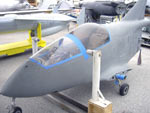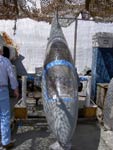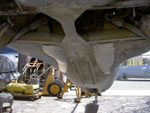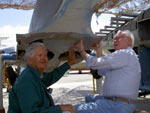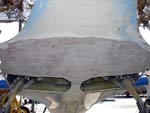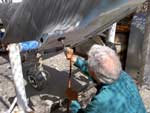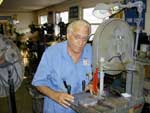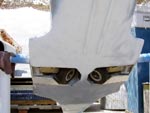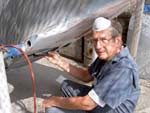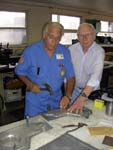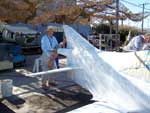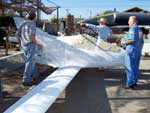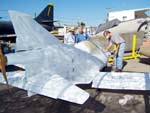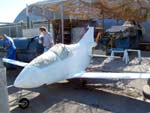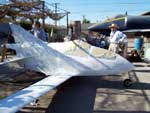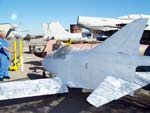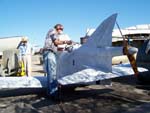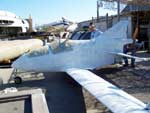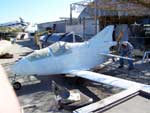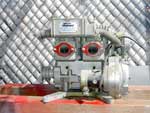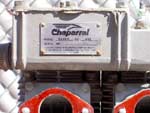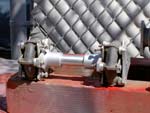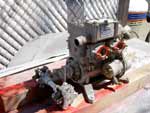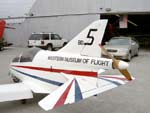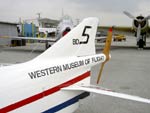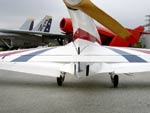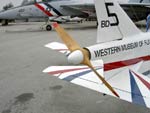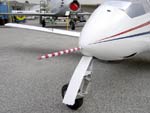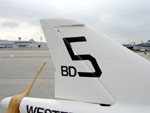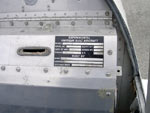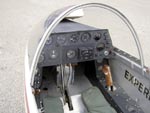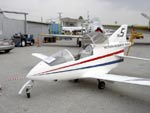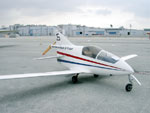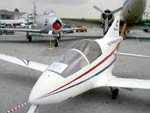The BD-5 is a high performance, single place, low wing, all metal pusher aircraft designed for recreational flying. Designed by James Bede in the 1970s, it was to be a home built plane that could fly over 200 mph using just a 40hp engine. He offered to sell the plane kit to individuals for $2,100 complete. The average construction time was about 3000+ hours.
The prototype BD-5A first flew in 1971 with a 40hp 2-cylinder engine powering a pusher propeller. The control stick for all BD-5s was mounted on the right hand side and was controlled by wrist action, rather than the conventional stick in the middle of the cockpit. Bede Aircraft Company went bankrupt in 1979 and a company called BD Micro Technologies Inc now sells the BD-5 airplanes. The BD-5 was featured in the James Bond movie Octopussy.
The BD-5 promised tremendous performance at a minimal cost to build and to operate. Over 1700 BD-1 were produced. This was the first light aircraft mass-produced using bonded (glued) metal construction. The BD-2 was designed to fly non-stop around the world without refueling. The BD-4 wing used a patented "panel-rib" process. The four-seat BD-4 was moderately successful and Bede sold about 600 kits. When initially introduced, over 4,000 BD-5 kit orders were received.
The single-seat aircraft is13.3 ft long and has a wing span of 21.5 ft. with a retractable tricycle landing gear. In the hands of a qualified pilot, the BD-5 could perform a full range of aerobatic maneuvers. The light control force required to control the aircraft is achieved by the use of push-rods supported on ball bearings.
The BD-5's gross weight is between 660 and 850 pounds depending on the engine. Initially, the BD-5 came with a 40 horsepower, two-cylinder, two-cycle, in-line and air-cooled Keikaefer power plant. This engine proved to be unreliable.
After Bede went bankrupt, Bede-Micro Aviation in San Jose, California, was formed to carry on the BD-5 and provide an improved engine for the aircraft, a turbo-charged Honda Civic automobile engine. The present engine of choice is the Rotax 582. About 150 BD-5's were still flying in 2002.
The Restoration
The Western Museum of Flight acquired its BD-5 ( serial number 1808) in 1997. The aircraft was built in 1978 and used a 52 hp Chaparral engine. Restoration was started in March of 2005. An inspection of the aircraft showed extensive damage to the undercarriage. The first step in the restoration process was to build a fixture to allow access to the damaged area.
The finished fixture |
Mounted |
Damage |
Repaired damage |
Continuing the repairs |
Completed aft section |
Completing the repairs |
Starting the prop ring |
Restored wheel wells |
Finishing Surface |
Building Wheel Covers |
Prepping for Painting |
Priming the BD-5 |
|||
Completing the Job |
|||
52 hp Chaparral engine |
|||
|
Presently on display at the Western Museum of Flight at the Torrance Airport, California
|
|||

